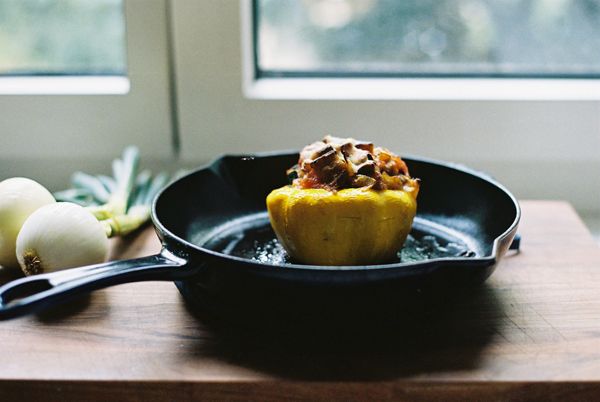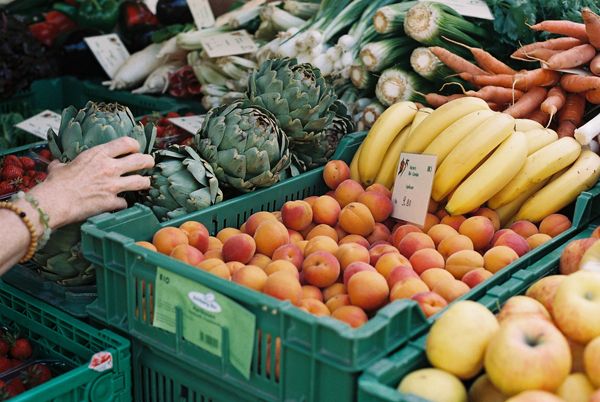You should know from the get-go that this is not a strict recipe, no, not at all. This dish fits more into the wing-it, go-with-your-gut, whatever-makes-you-happy type of recipe. At least that is how I approached it. I'm currently struggling with an apricot addiction, which severely limits my ability to think about things besides compote, crumble and jam. And in all honesty I only bought the squash after looking into my market bag and realizing that I had approximately three kilos of fruit and not a single vegetable. Eager to create some semblance of equanimity in the produce department I bought a beautiful, well nourished - read thoroughly water-logged - pattypan squash.
Okay, great, so I had a vegetable, a beauty at that, but I had absolutely no idea what I was going to do with it, not even an inkling of an idea. It was a process of elimination really. I knew what I wasn't going to do with it: I wasn't going to set it on a cutting board and chop it up, nope too pretty for such an end, I also knew I wasn't going to use it on the mantle as decoration - it's not fall yet and my mantle is currently busy showing off driftwood and smooth beach rocks. No chopping or mantle trimming meant I had to stuff it, so I did.
It might have been my recent trip to Paris or perhaps it was the fact that Zach recently informed me that he loves eggplants, but either way I decided to stuff it with a make-shift ratatouille. I love ratatouille. I always forget how much I love it. It's all things homey and comforting and delicious, wrapped into a few vegetables, some salt and a bit of stirring. Ultimately the pattypan squash proved to be an edible vessel, a beautiful one at that, for ratatouille eating. That said, I do think the softness of the squash, in flavor and texture, helped to balance the mushy acidity of the tomatoes and eggplants, a little bit like eating ratatouille with rice or cous cous.
// ratatouille stuffed patty pan squash //
serves 2
As mentioned above, this is really a little-bit-of-this-little-bit-of-that type of recipe. Feel free to add and subtract as your taste buds dictate. I think it would be delicious with feta cheese instead of parmesan. It would also be good with a drizzle of good pesto on top. If you can't find a patty pan squash you can easily substitute something from the zucchini family.
This makes more stuffing than will fit in the squash. Once the squash was done we spooned extra ratatouille on our plates.
ingredients
1 medium sized pattypan squash
olive oil
butter
1 spring onion, chopped
1 medium eggplant
1 zucchini, thickly chopped
10 or so cherry tomatoes, halved
1 recipe Marcella Hazan's tomato sauce
salt and pepper
parmesan cheese
Preheat the oven to 400ºC/200ºC
Slice the top off of the squash, flip and slice the bottom off. With the bottom facing up scoop out the flesh and seeds, and reserve. Place the squash in an oven safe cast iron pan, drizzle with oil and place in the oven. Cook the squash until it is fork-tender, about 30-40 minutes (check starting around 20 minutes, because heck you never know).
Slice the eggplant into thick slices. Sprinkle the slices with salt and let them sit for about 20 minutes. This will allow them to sweat out their bitterness. If your eggplants are small and young, then you can likely skip this step. Blot the eggplants and chop into dice size pieces, or even slightly larger.
Heat one tablespoon of oil and one tablespoon of butter in a pan over medium heat. Add the onion to the pan and saute and until softened. Chop the pattypan squash remnants and add them to the onions along with the zucchini and eggplant. Continue to stir and saute until soft - you might want to add a bit more butter and oil. Add the cherry tomatoes, stir. Starting with a little bit at a time add the tomato sauce until the ratatouille reaches a consistency that you like. Season with salt and pepper.
Fill the pattypan squash with as much ratatouille as will fit and top with grated cheese. Return back to the oven for about 15 minute or until cheese has melted and juices are dripping. Keep the remaining ratatouille hot on the stove. Cut in half and enjoy with an extra scoop of ratatouille.
We've been eating on the balcony recently, it's been heavenly.






















































